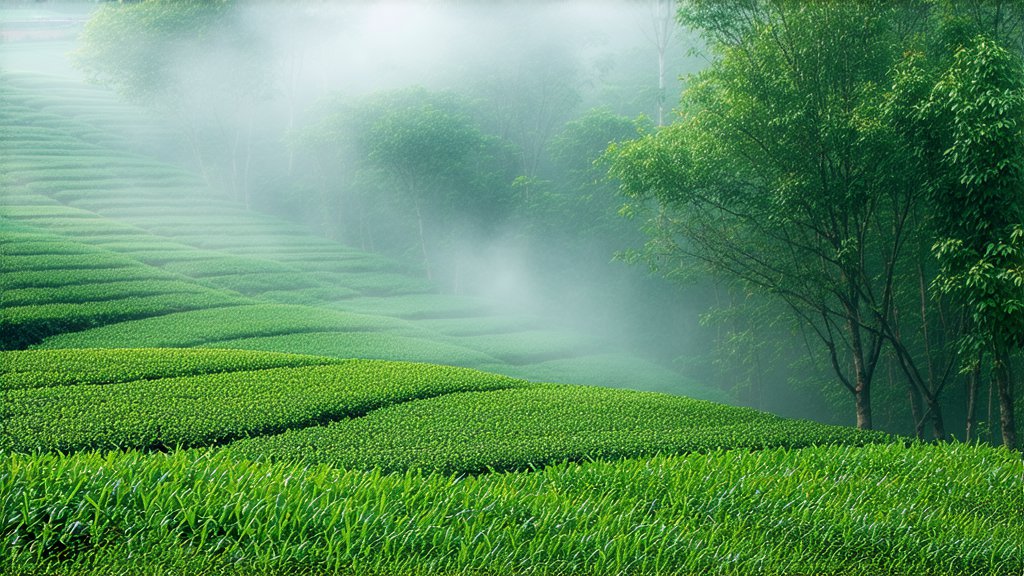
Junshan Yinzhen, often hailed as a gem within the vast spectrum of Chinese teas, stands out not only for its rare production but also for its distinctive flavor profile that captivates the senses. This exquisite yellow tea originates from Junshan County in Hunan Province, nestled amidst the picturesque landscapes of the Dongting Lake region. With a history intertwined with the cultural tapestry of China, Junshan Yinzhen embodies the essence of traditional tea-making artistry passed down through generations.
A Glimpse into History
The tale of Junshan Yinzhen traces back to ancient times when it was first discovered by accident during the Tang Dynasty (618-907 AD). Legend has it that a local farmer left freshly harvested tea leaves exposed to damp conditions overnight. Upon returning the next day, he found the leaves had undergone a spontaneous fermentation process, turning them yellow and imbuing them with a unique aroma and taste. This serendipitous discovery led to the development of what we now know as Junshan Yinzhen.
Throughout centuries, Junshan Yinzhen has been cherished as an imperial tribute tea, enjoyed by emperors and nobility alike. Its reputation as a symbol of prestige and refinement grew, cementing its place in Chinese tea lore.
Varieties and Classification
While there are several varieties of yellow tea produced across China, Junshan Yinzhen is particularly renowned for its exceptional quality and limited production. It is classified under the 'Huang Ya' (yellow bud) category, which refers to the use of young tea buds and leaves in its making. These buds are meticulously handpicked, ensuring only the finest specimens make it into the final product.
The Art of Crafting Junshan Yinzhen
The production of Junshan Yinzhen is a meticulous process that requires precision and patience. Here's an overview of the key steps involved:
-
Harvesting: The journey begins with the selective picking of tender buds and leaves, typically during the early spring season when they are most succulent and rich in nutrients.
-
Fixation: Unlike other teas that undergo immediate heat treatment, Junshan Yinzhen undergoes a gentle steaming or pan-firing process to halt oxidation gently. This step preserves the delicate flavors and natural sweetness of the tea.
-
Wrapping and Fermentation: One of the defining characteristics of Junshan Yinzhen is its unique wrapping technique. The fixed tea leaves are wrapped in bamboo mats or cloth and allowed to undergo a controlled fermentation process. This slow fermentation, often lasting several days, gives the tea its characteristic golden color and subtle, complex flavors.
-
Drying: Finally, the tea is carefully dried using low heat to remove any remaining moisture without compromising its delicate nature. This step ensures the tea's longevity and enhances its aroma.
Savoring the Essence: A Guide to Tasting Junshan Yinzhen
To truly appreciate Junshan Yinzhen, one must engage in a mindful tasting experience that involves all sensory faculties. Here’s a guide to help you embark on this journey:
-
Preparation: Begin by selecting a transparent glass teapot or gaiwan to fully appreciate the tea's visual appeal. Use water heated to around 80-85°C (176-185°F) to avoid scalding the delicate leaves.
-
Infusion: Place approximately 3-5 grams of Junshan Yinzhen per 200ml of water ratio. Let the tea steep for about 2-3 minutes for the first infusion. Subsequent infusions can be adjusted based on personal preference, typically increasing steeping time slightly with each brew.
-
Observation: As the tea infuses, observe the transformation of the dry leaves into a vibrant yellow hue, indicative of its name. Appreciate the clarity and brightness of the liquor.
-
Aroma: Bring the cup close to your nose and take a deep breath to capture the subtle floral and fruity notes that characterize Junshan Yinzhen. Note any hints of woodiness or sweetness.
-
Tasting: Sip slowly, allowing the tea to coat your palate. Notice the initial sweetness followed by a mild, lingering aftertaste that reflects the tea's gentle fermentation process. The texture should be smooth and velvety.
-
Reflection: Take a moment to reflect on the overall experience, appreciating how each sip connects you to centuries of tea culture and the artisans who crafted this exquisite beverage.
In conclusion, Junshan Yinzhen represents more than just a tea; it is a testament to China's profound tea heritage and the artistry involved in its creation. From its accidental discovery to becoming a coveted delicacy, every aspect of Junshan Yinzhen invites exploration and appreciation. Whether you're a seasoned tea connoisseur or a curious newcomer, savoring this golden elixir offers a glimpse into the soul of Chinese tea culture.
Keywords: Junshan Yinzhen, Yellow Tea, Chinese Tea Culture, Tea Production Process, Tea Tasting Guide, Huang Ya